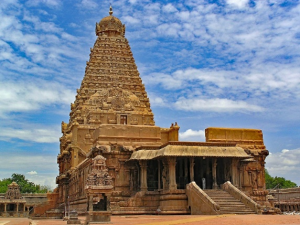Approach:
- Intro on Chola temple architecture.
- Description of Chola temples.
- Conclusion
The Chola kings were one of the foremost of India’s temple-building polities having power base in the Kaveri delta region. The period from the 9th – 13th century in southern India is regarded as one of the most creative & formative periods of Tamil culture, inspiring some of the finest artistic achievements. At least 300 stone temples were built, of which the greatest are at Thanjavur, Gangaikondacholapuram and Darasuram.

Temple architecture: Thanjavur, at the head of the Kaveri delta, became a Chola settlement from c. 850 and turned into a major political centre from Rajaraja’s reign. In terms of scale & grandeur, the temple founded by Rajaraja in Thanjavur marked a major change in the conception of Hindu temples in south India.
The Rajarajeshvara temple, is set within a large rectangular enclosure, which is entered through two monumental pyramidal gateways (gopurams). The temple is carefully aligned with the rising sun of the day. At the centre, a monumental stepped pyramidal tower (vimana) rises above the main shrine – the massive Shiva linga as Rajarajeshvara (the lord of Rajaraja). The sanctum (garbhagriha) houses the linga. No south Indian temple could aspire such a monumental single-towered shrine as at Thanjavur and its royal successors temples. The vimana is capped with a pot-finial (stupi). A long rectangular columned hall (mahamandapa) accommodates worshippers. This huge temple is built of hard granite with no mortar. The mastery of stone corbelling was the greatest technical achievement of Chola architects.
During the reign of Rajaraja’s son, Rajendra Chola, a new capital city was built which was named Gangaikondacholapuram (the City of the Chola who conquered Ganges). A new stone temple on similar scale of Thanjavur had been built on a rectilinear plan. The symbolic conquest of the universe is depicted with Mount Kailasa – Northern & Southern Kailasa on either side of the main temple. It houses Shiva as Rajendracholishvara (Lord of Chola Rajendra), besides displaying other Hindu deities like Durga, Surya, Ardhanarishvara, etc. The temple is famed for its bronze sculptures, artwork on its walls, the depiction of Nandi and the scale of its tower. The temple is also noteworthy for its numerous inscriptions. The temple had several employees and musicians to recite tevaram, hymns of praise composed by Tamil Shaiva poet saints.
The third is the Airavateshvara temple at Darasuram. It was patronised by Rajaraja II, and dedicated to Shiva. The main temple’s vimana is 24 m in height, preceded by a series of mandapas entered on the south with stone wheels and rearing horses – the mandapa being modelled as temple chariot (ratha). A further monumental temple was built in Kulottunga III’s reign dedicated to goddess Devanayaki – the earliest separate goddess shrines. It is striking for its exceptional volume and quality sculptures like Shiva as Gajasamhara (slayer of elephant-demon). It is the first temple to include the frieze of complete series of all Nayannars.
Thus, the Chola contribution left a high watermark in India’s temple architecture. Their royal patronage, monumental singularity and exquisite sculpture makes them appealing. No doubt, the Brihadishvara temple (Thanjavur), Gangaikondacholapuram temple and Airavateshvara temple (Darasuram) were declared as World Heritage Sites by UNESCO, collectively forming the Great Living Chola Temples.
